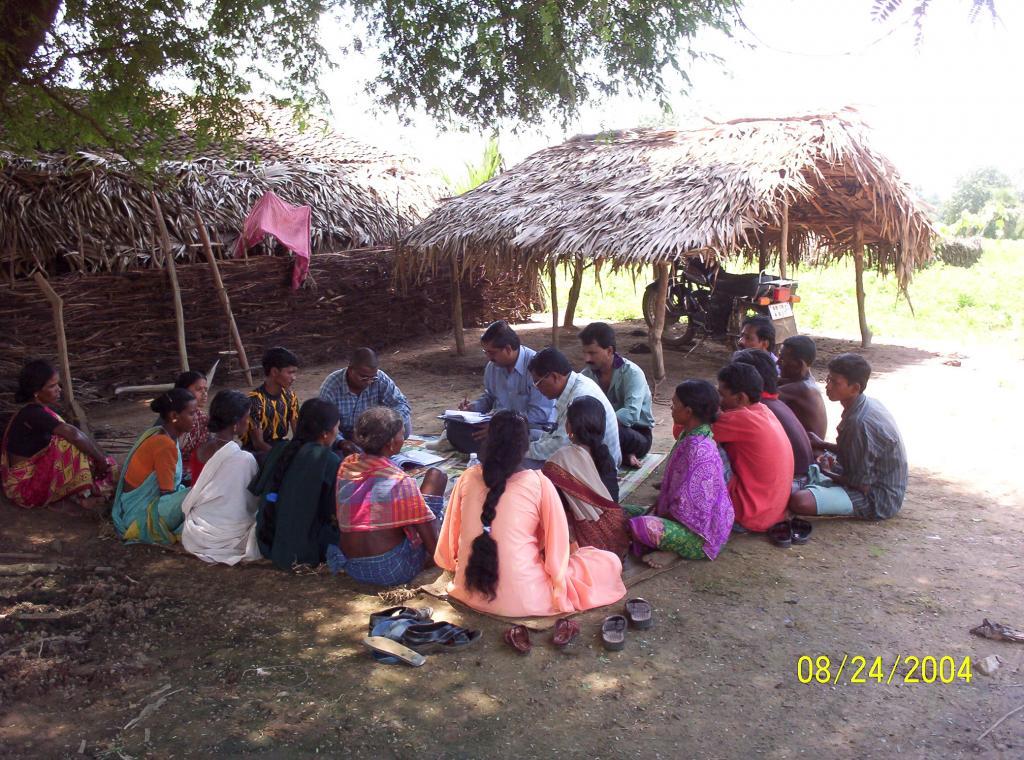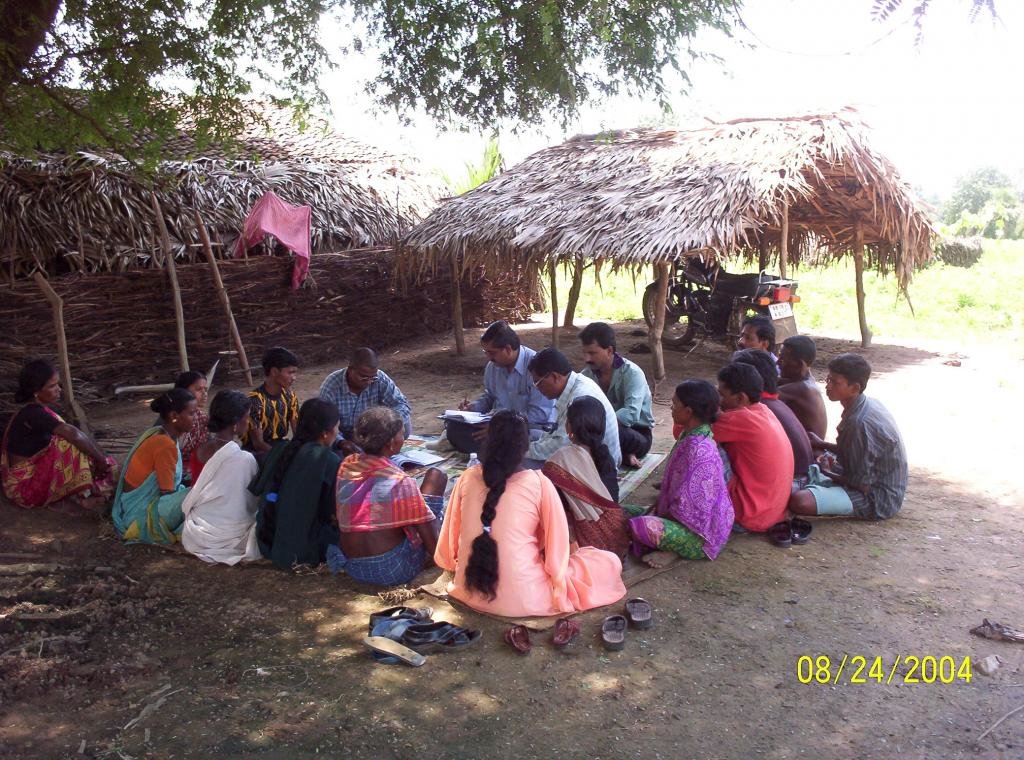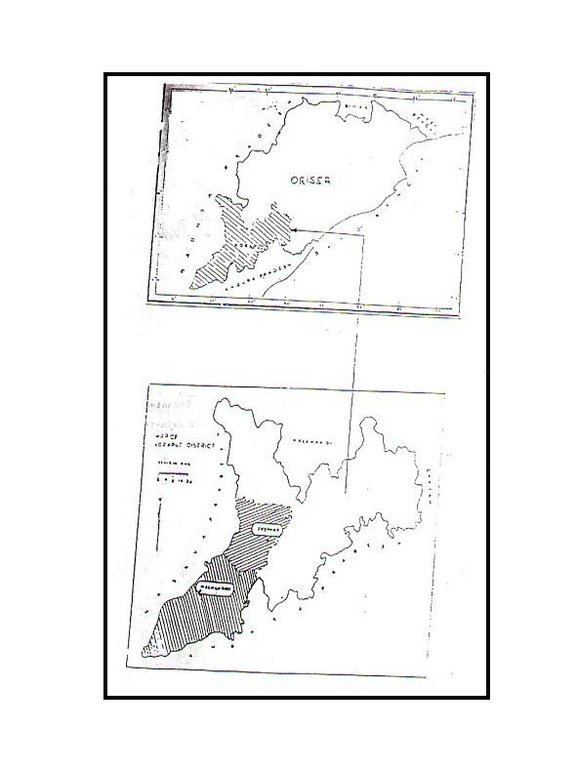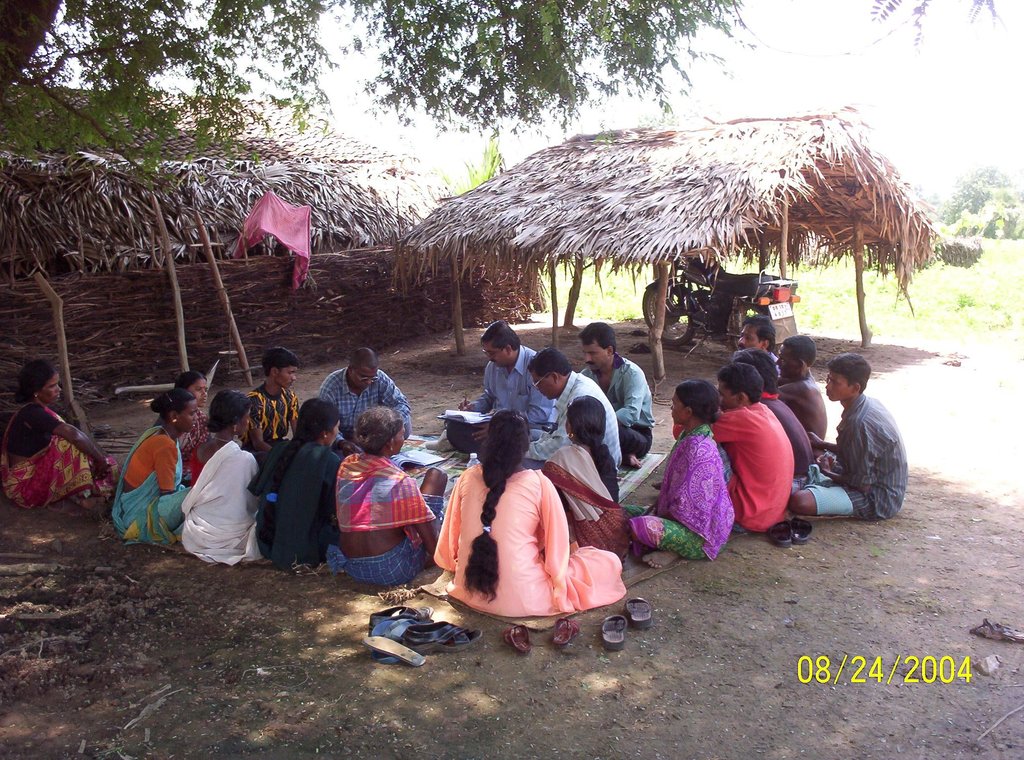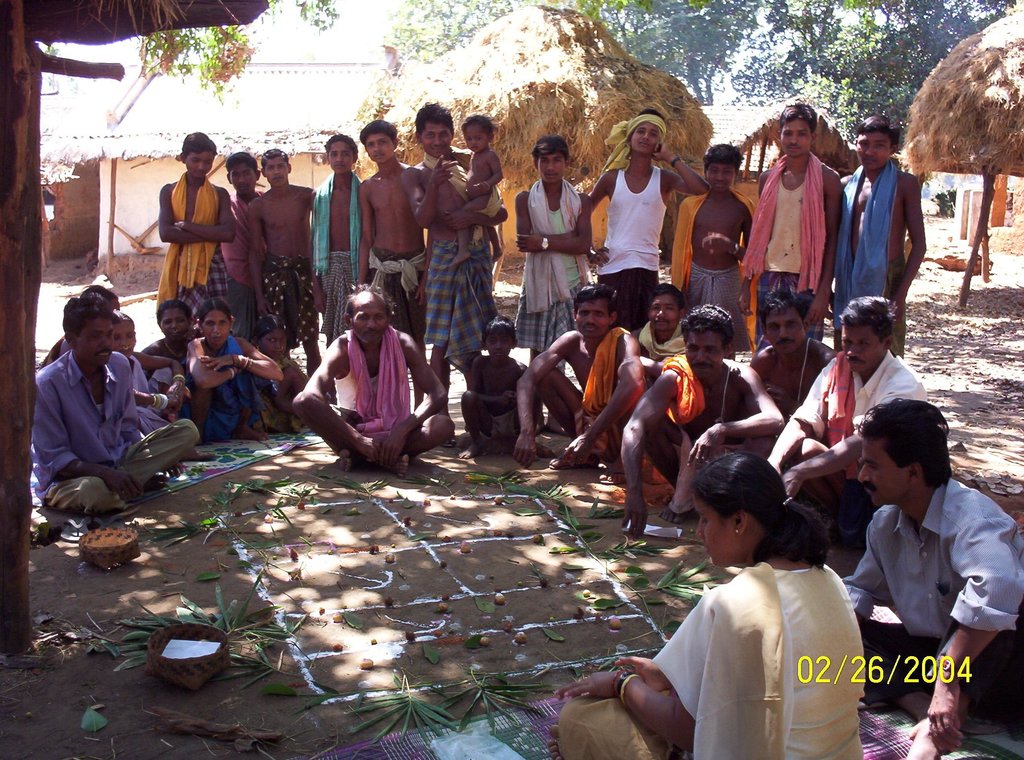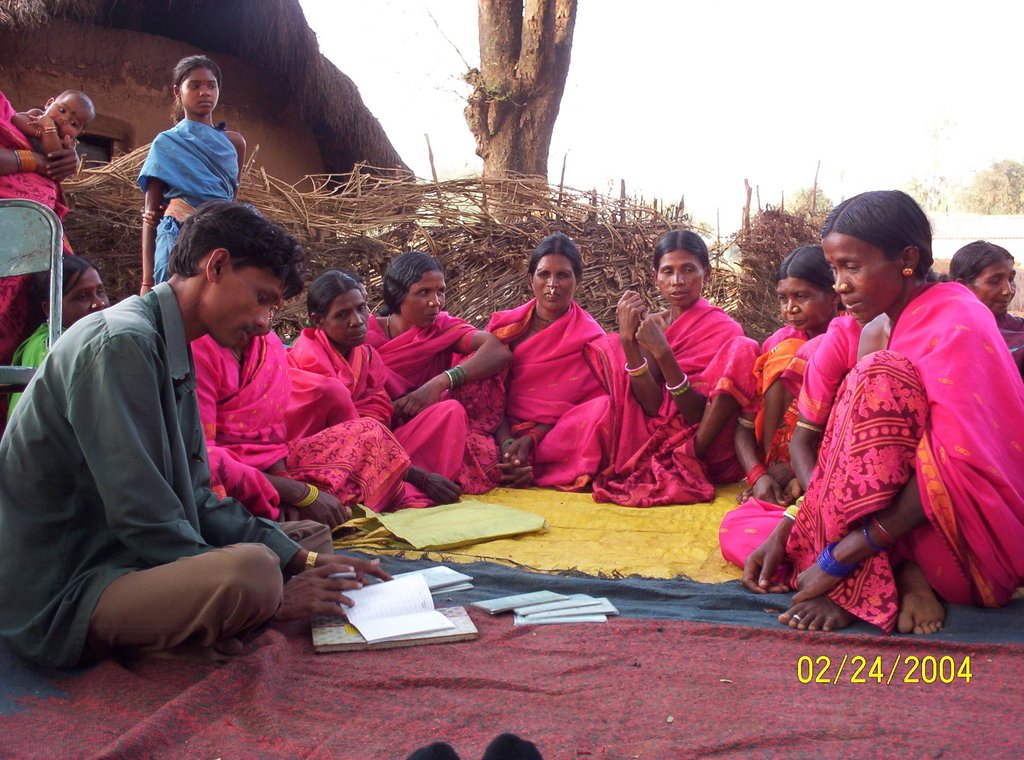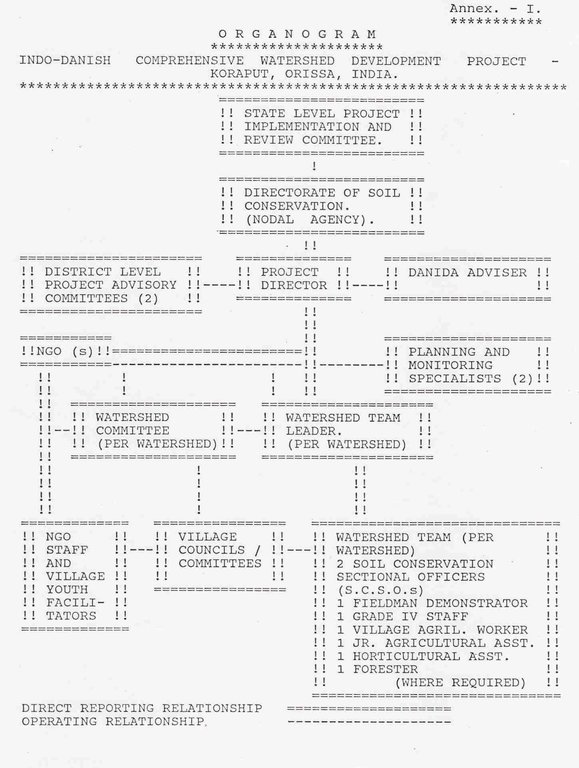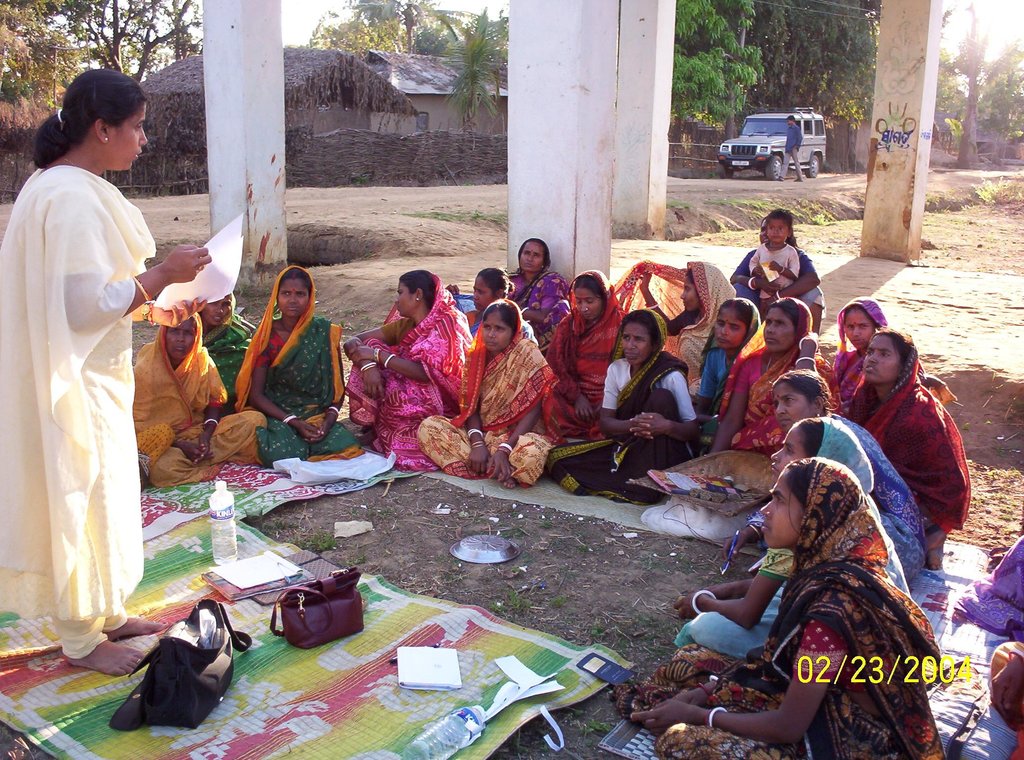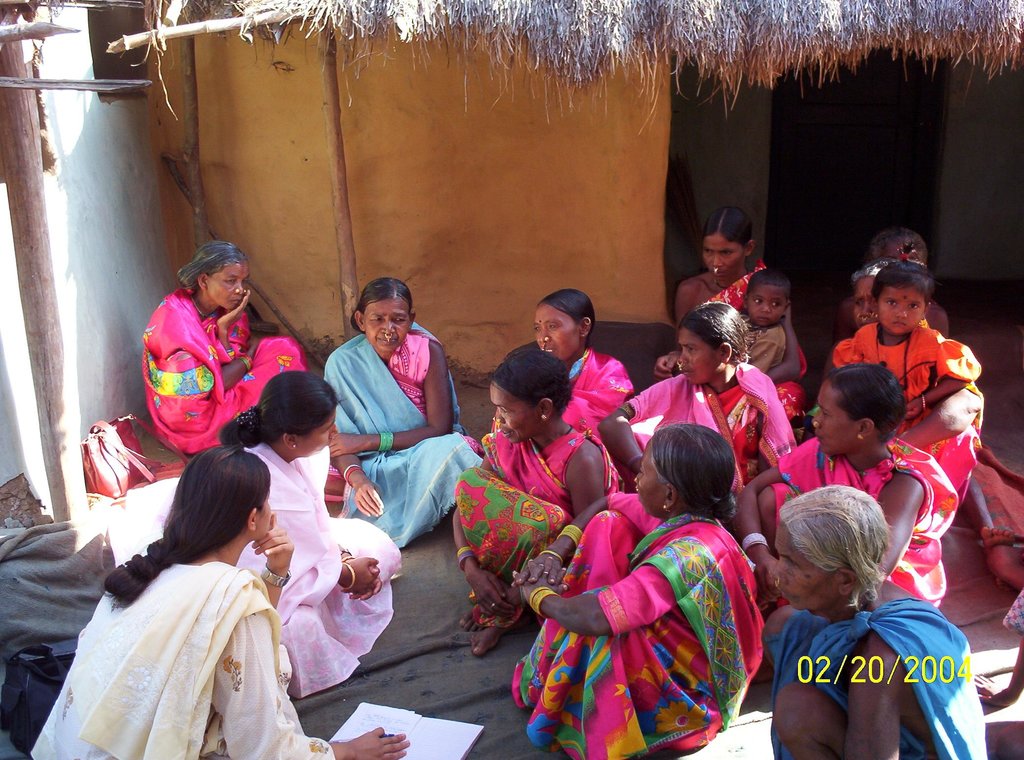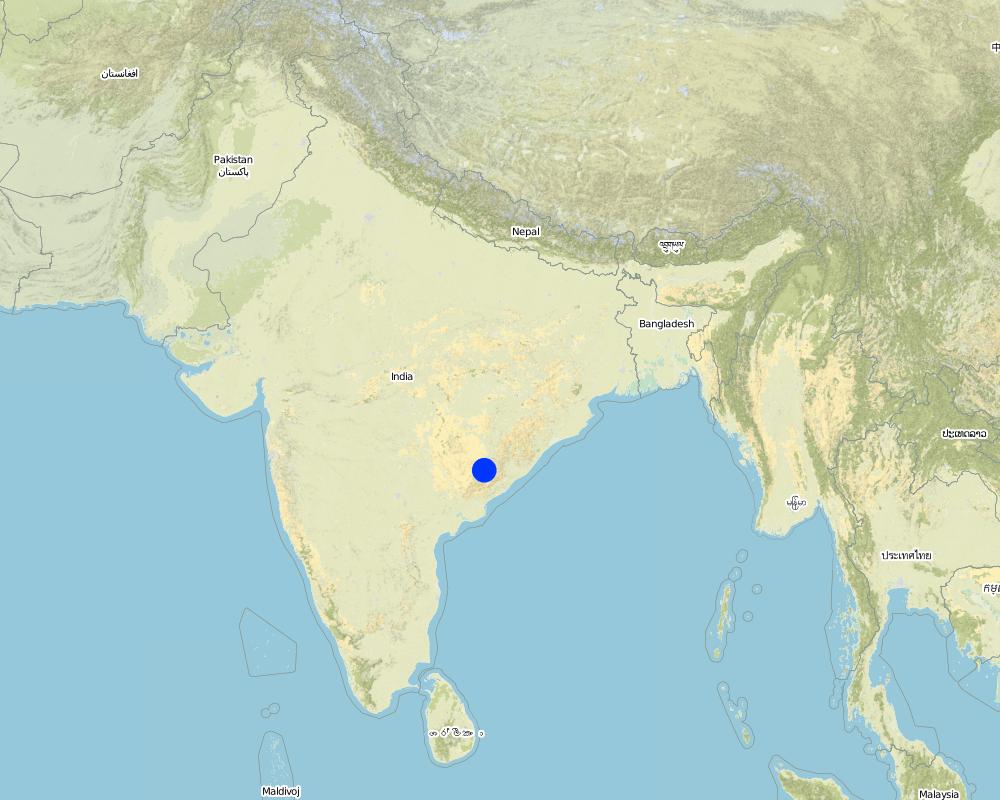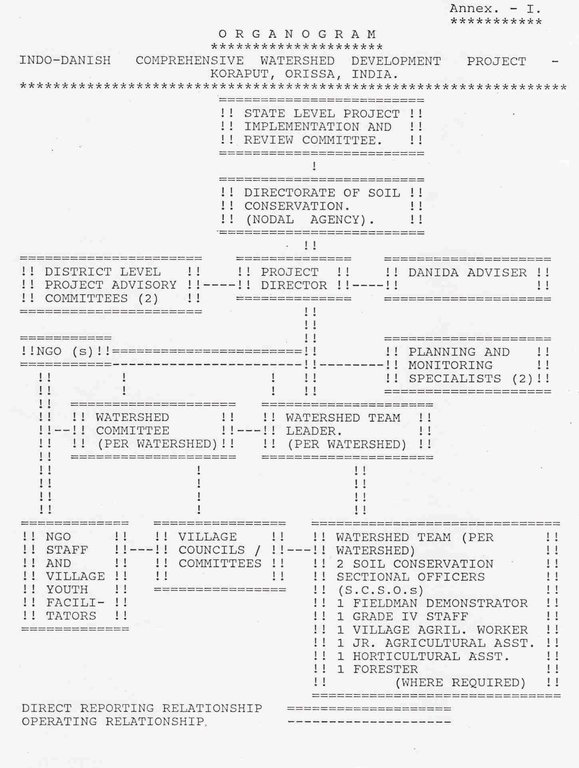PARTICIPATORY APPROACH IN IDCWDP, DANIDA [อินเดีย]
- ผู้สร้างสรรค์:
- การอัพเดท:
- ผู้รวบรวม: Srikanta Kumar Parida
- ผู้เรียบเรียง: –
- ผู้ตรวจสอบ: Fabian Ottiger
approaches_2372 - อินเดีย
ดูส่วนย่อย
ขยายทั้งหมด ย่อทั้งหมด1. ข้อมูลทั่วไป
1.2 รายละเอียดที่ติดต่อได้ของผู้รวบรวมและองค์กรที่เกี่ยวข้องในการประเมินและการจัดเตรียมทำเอกสารของแนวทาง
ผู้เชี่ยวชาญ SLM:
BIJAYALAXMI Mishra
อินเดีย
ชื่อของโครงการซึ่งอำนวยความสะดวกในการทำเอกสารหรือการประเมินแนวทาง (ถ้าเกี่ยวข้อง)
Orissa Government - อินเดีย1.3 เงื่อนไขที่เกี่ยวข้องกับการใช้ข้อมูลที่ได้บันทึกไว้ผ่านทาง WOCAT
ผู้รวบรวมและวิทยากรหลักยอมรับเงื่อนไขเกี่ยวกับการใช้ข้อมูลที่ถูกบันทึกผ่านทาง WOCAT:
ใช่
1.4 การอ้างอิงถึงแบบสอบถามเรื่องเทคโนโลยี SLM
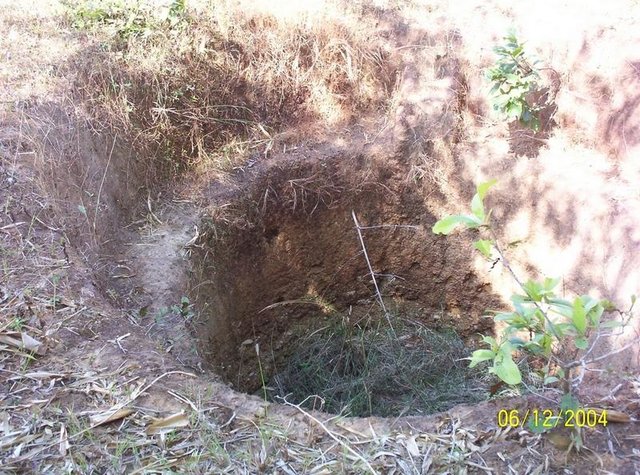
Integrated Farming System [อินเดีย]
Growing of crops for food, fodder trees and fibre forest in a compact patch.
- ผู้รวบรวม: Srikanta Kumar Parida
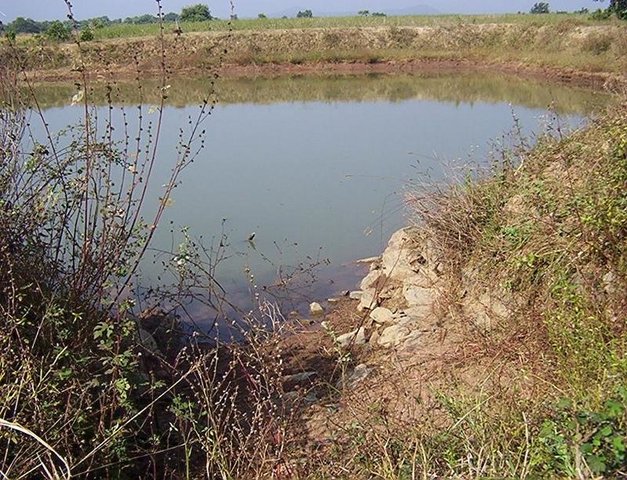
Dugout Sunken Pond with Catchment Treatment [อินเดีย]
Dugout sunken pond with catchment treatment.
- ผู้รวบรวม: Unknown User
2. คำอธิบายของแนวทาง SLM
2.1 การอธิบายแบบสั้น ๆ ของแนวทาง
Participatory approach for holistic and intigrated development of the defined area on watershed basis involving all level of stake holders.
2.2 การอธิบายอย่างละเอียดของแนวทาง
การอธิบายอย่างละเอียดของแนวทาง:
Aims / objectives: Long term - Establish suitable and locally acceptable land use system which are sustainable and ecologically sound.The land use system should enable the poor rural community to improve their living condition and tsupply of food, fuel and fodder and other essentials, without exposing the natural resources to harmful stress. Intermediate Objective- Preserve the resource base by introducing improvemnets which are feasible, effective and attractive to the target groups in the area by combining elements of soil conservation, crop production, horticulture, animal husbandary and tree planting in such a way that sustaibale use is made of every niche of land within the watershed.
Methods: (1) Mobilization of community by NGO/ GO people through meetings. (2) Demonstration at the field level. (3) Organizing farmers field day. (4) Exposure visit to the watershed area. (5) Training. (6) Land development activities,
Stages of implementation: (1) Socio economic survey. (2) Participatory Rural Apprisal (PRA). (3) Preparation of participatory annual action plan with the community and village and watershed committee. (4) Consolidation of annual action plan by project management unit and circulation for comments to WDCU, DSC(O). (5) Approval of annual action plan by the state level project empowered committee and sanction of funds. (6) Implementation through community and mobilisation for labour contribution by the community (if such component are there). (7) Training at the field level. (8) Organizing monitoring by the community/ Specialist.
Role of stakeholders: NGO (Field Organizers)- Organizing village meeting and mobilization of community towards different activities and labour contribution organising PRA, meeting, group discussion, survey, formation of committee, preparation of AAP. Villagers:- Attendance of meeting, selection of beneficiaries from the target group and sites for different activities. Monitoring and implementation (Physical) of the activity. Youth facilitator:- The village youth facilitators played a key role through out the process of planning, implementation and monitoring and to solve the problems in case arises at any stage of the work. The village yourth facilitator acted as the link person between the community and the project. SWC (From Project management Unit) - Supervision, training to the SWC specialist, communicate new technology to the community. Beneficiaries:- Implementation, contribution of labour selection of his own land for SWC technology, monitoring, receive training, training before/during/afteer care.
Other important information: Government and NGO collaborately played a vital role to bring all level of stak holders to a common forum of participation.
2.3 รูปภาพของแนวทาง
2.5 ประเทศ ภูมิภาค หรือสถานที่ตั้งที่ได้นำแนวทางไปใช้
ประเทศ:
อินเดีย
ภูมิภาค/รัฐ/จังหวัด: :
Orissa
Map
×2.6 วันที่เริ่มต้นและสิ้นสุดของแนวทาง
การสิ้นสุดลง (ถ้าแนวทางไม่ได้ใช้อีกต่อไป):
2003
2.7 ประเภทของแนวทาง
- ใช้โครงงานหรือแผนงานเป็นฐาน
2.8 เป้าหมายหรือวัตถุประสงค์หลักของแนวทาง
The Approach focused mainly on SLM with other activities (Live stock development, SHG formation, management group, development of local committee, income generating, identification of 10 poorest and support for upliftment, training, women empowerment)
Long term - Establish suitable and locally acceptable land use system which are sustainable and ecologically sound. The land use system should enable the poor rural community to improve their living condition and tsupply of food, fuel and fodder and other essentials, without exposing the natural resources to harmful stress. Intermediate Objective- Preserve the resource base by introducing improvemnets which are feasible, effective and attractive to the target groups in the area by combining elements of soil conservation, crop production, horticulture, animal husbandary and tree planting in such a way that sustaibale use is made of every niche of land within the watershed. -Ease the pressure on non arable lands by increasing the productivity of land which is suitable for more intensive use which is suitable for more intesive use without risk of loss in soil fertility. -Provide marginal farmers and landless people with assests which yield essentials or generate income possibilities. Immediate: Relevant authorities will identify, plan for implement and monitor proper conservation measures and land use system acceptable and in cooperation with the people in the project area of Koraput and Malkangiri districts. Thereby increase production of agricultural and other rural products and improve gainful, empowerment opportunity for men and women among landless , small and marginal farmers.
The SLM Approach addressed the following problems: (1) Both the project districts like Koraput & Malkangiri are among the most poor, backward with 90% of the house hold are below the official poverty line. Literacy rate is just above 10%. (2) The dry land farming is predeminant activity. (3) The soil in the districts suffer from severe land degradation and erosion problems needing protectin and preservation measures.
2.9 เงื่อนไขที่เอื้ออำนวยหรือเป็นอุปสรรคต่อการนำเทคโนโลยีภายใต้แนวทางนี้ไปปฏิบัติใช้
บรรทัดฐานและค่านิยมทางสังคม วัฒนธรรม ศาสนา
- เป็นอุปสรรค
(1) No faith on Govt. people. (2) Practice on not participapting in any Govt. programme. (3) No women participation in any common gathering. (4) Dominance of influencial persons in the villages. (5) No participation of poors in any developmental work.
Treatment through the SLM Approach: (1) Repeated meeting by Govt. and NGO staff (2) Greter importance to the poorer section through out the process. (3) Identification of 10 poorest family in each village (4) Engagement of Lady organizer to oroganize the women of the respective area. (5) Fo
การมีไว้ให้หรือการเข้าถึงแหล่งการเงินและบริการ
- เป็นอุปสรรค
Irregular flow of fund by the sanction authority which hampered the season based activities.(2)Achieve the targetted amount of contribution for different activities from the community.
Treatment through the SLM Approach: The irregular funds flow continued till end of the programme.But regarding contribution component it was reduced from the 50% to20% in amount at the policy level which could be achieved by community mobilisation through NGO who were associated as the proj
กรอบแนวทางในการดำเนินการด้านกฎหมาย (การถือครองที่ดิน สิทธิในการใช้ที่ดินและน้ำ)
- เป็นอุปสรรค
The existing land ownership, land use rights / water rights hindered a little the approach implementation Due to ignorance of the people, initially it was difficult to take up any activity in farmers land since the apprehensive of loss of llllland by the Govt. Staff was existing in the mind of land users.
3. การมีส่วนร่วมและบทบาทของผู้มีส่วนได้ส่วนเสียที่เกี่ยวข้อง
3.1 ผู้มีส่วนได้ส่วนเสียที่เกี่ยวข้องในแนวทางนี้และบทบาท
- ผู้ใช้ที่ดินระดับท้องถิ่นหรือชุมชนระดับท้องถิ่น
Land less and Small/marginal farmers
Work equally divided between men and women (Both men and women work on common land activities, the land users worked combinely and in most of the private activities work done individualy. Though the male and female do all type of work, but due to their usual practice the women participation was very less in the initial period of the project. But due to the presence of the NGO in the project, they could be brought in the main stream of the project and by which many successful women self help group than the male group could be organized. The project has earmarked poor as main target froup. Through NGO they have been encouraged and mobilized to partcipate in project activities. As per the project guide line no land less and the small/ marginal farmers have their representation in the village committee/watershed committee wheremajor decission taken place. During implementation they priority for engegement of labour and income.
- องค์กรพัฒนาเอกชน
NGO as project partner
- รัฐบาลแห่งชาติ (ผู้วางแผน ผู้ทำการตัดสินใจ)
Ministry of Agriculture, India.
(1) Watershed development coordination unit (2) State Agriculture Department (3) Director of Soil Conservation
3.2 การเกี่ยวข้องของผู้ใช้ที่ดินระดับท้องถิ่นหรือชุมชนระดับท้องถิ่นในช่วงต่างๆของแนวทาง
| ความเกี่ยวข้องของผู้ใช้ที่ดินระดับท้องถิ่นหรือชุมชนระดับท้องถิ่น | ระบุผู้ที่มีส่วนเกี่ยวข้องและอธิบายกิจกรรม | |
|---|---|---|
| การริเริ่มหรือการจูงใจ | จ่ายเงินหรือสนับสนุนจากภายนอก | public meetings; General village level meeting organized village committee members selected. Youth facilitator selected. Due to presence of NGO all villagers were mobilized to join in the mainstream of the project. |
| การวางแผน | ปฏิสัมพันธ์ | All community were associated in planning meeting and PRA . Addl land survey made in association with land users. Need assessment made for each house hold in association with the villagers. Approval of action plan in watershed and village committee. |
| การดำเนินการ | จ่ายเงินหรือสนับสนุนจากภายนอก | |
| การติดตามตรวจสอบหรือการประเมินผล | ปฏิสัมพันธ์ | At different level of meeting the land users views collected. The watershed committee (consisting of members from all villages) was the main body for monitoring and evaluation of the activities. |
| Research | ปฏิสัมพันธ์ | on-station; Only for limited activities some soil testing made in the soil research station of the district. |
3.3 แผนผังแสดงขั้นตอนการทำงาน (ถ้ามี)
3.4 การตัดสินใจเลือกใช้เทคโนโลยี SLM
ระบุผู้ที่ทำการตัดสินใจเลือกเทคโนโลยีมากกว่าหนึ่งวิธีไปปฏิบัติใช้:
- ผู้ใช้ที่ดินเป็นผู้ตัดสินใจหลัก โดยการสนับสนุนจากผู้เชี่ยวชาญ SLM
การอธิบาย:
Many technologies has been takn up from the guide line of NWDPRA. But some are also innovative one emerged from the project level. However whenever any technology decided to be implemented, the land users view aloways respected for sustainable of the activity and transferred appropriate technology.
Decisions on the method of implementing the SLM Technology were made by mainly by land users supported by SLM specialists. Relating to the method of implementation fo the activity, the suggestion of the land users played a vital role.
4. การสนับสนุนด้านเทคนิค การสร้างขีดความสามารถ และการจัดการด้านความรู้
4.1 การสร้างขีดความสามารถ / การอบรม
ได้มีการจัดอบรมให้แก่ผู้ใช้ที่ดินหรือผู้มีส่วนได้ส่วนเสียคนอื่น ๆ หรือไม่:
ใช่
ให้ระบุว่าใครเป็นผู้ได้รับการอบรม:
- ผู้ใช้ที่ดิน
- SWC specialists, extensionists/trainers, Local Invitor
รูปแบบการอบรม:
- กำลังดำเนินการ
- เกษตรกรกับเกษตรกร
- ใช้พื้นที่ทำการสาธิต
- จัดการประชุมสู่สาธารณชน
- จัดคอร์ส
รูปแบบการอบรม:
- Courses and class room training
หัวข้อที่พูด:
Method of implementation, merits, demerits of the technology, maintenance, socio-economic dimension, exposure visit, management committee formation for sustainability of the technolotgy.
4.2 การบริการให้คำแนะนำ
ผู้ใช้ที่ดินมีการเข้าถึงการรับบริการให้คำปรึกษาหรือไม่:
ใช่
ระบุว่ามีบริการให้คำปรึกษาหรือไม่:
- ที่ศูนย์ถาวร
การอธิบาย/แสดงความคิดเห็น:
Name of method used for advisory service: Training and exposure visit, demonstration, meeting.; Key elements: Meeting and group discussion., Individual beneficiary interaction., Filed visit and watershed level exihibition.; 1) Advisory service was carried out through: projects own extension structure and agents; Extension staff: mainly government employees 3) Target groups for extension: land users; Activities: Demonstration, exposure visit, training, meeting, group discussion
Advisory service is inadequate to ensure the continuation of land conservation activities; In knowledge it is adequate, but the approach is plicy based. So the continuation can not be guaranted fully.
4.3 การเสริมความแข็งแกร่งให้กับสถาบัน (การพัฒนาองค์กร)
สถาบันได้รับการจัดตั้งขึ้นมาหรือเสริมความแข็งแกร่งโดยแนวทางนี้หรือไม่:
- ใช่ ปานกลาง
ระบุระดับของสถาบันที่ได้รับการเสริมความแข็งแกร่งหรือจัดตั้งขึ้นมา:
- ท้องถิ่น
ระบุประเภทของการให้ความช่วยเหลือสนับสนุน:
- การสร้างขีดความสามารถ / การอบรม
4.4 การติดตามตรวจสอบและประเมินผล
การติดตามตรวจสอบและประเมินผลเป็นส่วนหนึ่งของแนวทางหรือไม่:
ใช่
ความคิดเห็น:
bio-physical aspects were regular monitored through observationse
technical aspects were regular monitored through measurements
socio-cultural aspects were regular monitored through observations
economic / production aspects were ad hoc monitored through observations
area treated aspects were regular monitored through measurements
no. of land users involved aspects were regular monitored through measurements
management of Approach aspects were regular monitored through measurements
There were several changes in the Approach as a result of monitoring and evaluation: (1) Many new activities introduced. (2) More funds diverted to the poverty oriented activities (3) Like income generating activities changes in last norm of NGO operational expenditure to give more priority on community participation. (4) 10 poorest identified were appreciated and suggested for concetration of their socio economic upliftment.
4.5 การวิจัย
การวิจัยเป็นส่วนหนึ่งของแนวทางหรือไม่:
ใช่
5. การสนับสนุนด้านการเงินและวัสดุอุปกรณ์
5.1 ระบุงบประมาณประจำปีสำหรับแนวทาง SLM นี้
ถ้าหากว่างบประมาณประจำปีไม่เป็นที่ทราบแน่นอน ให้ระบุช่วงลงไป:
- < 2,000
แสดงความคิดเห็น (แหล่งของการระดมทุน ผู้บริจาคคนสำคัญ):
Approach costs were met by the following donors: government (national - Salary and other expences of staff): 18.0%; international (DANIDA 13.25): 75.0%; local community / land user(s) (-): 7.0%
5.2 การสนับสนุนด้านการเงิน / วัสดุอุปกรณ์ให้แก่ผู้ใช้ที่ดิน
ผู้ใช้ที่ดินได้รับการสนับสนุนด้านการเงิน / วัสดุอุปกรณ์ไปปฏิบัติใช้เทคโนโลยีหรือไม่:
ใช่
5.3 เงินสนับสนุนสำหรับปัจจัยนำเข้า (รวมถึงแรงงาน)
- อุปกรณ์
| ระบุปัจจัยนำเข้าที่ได้รับการสนับสนุน | เห็นด้วยระดับไหน | ระบุเงินสนับสนุน |
|---|---|---|
| เครื่องจักร | ได้รับการช่วยเหลือทางการเงินแบบเต็ม | |
| เครื่องมือ | ได้รับการช่วยเหลือทางการเงินแบบเต็ม | |
- การเกษตร
| ระบุปัจจัยนำเข้าที่ได้รับการสนับสนุน | เห็นด้วยระดับไหน | ระบุเงินสนับสนุน |
|---|---|---|
| เมล็ด | ได้รับการช่วยเหลือทางการเงินแบบเต็ม | |
| ปุ๋ย | ได้รับการช่วยเหลือทางการเงินแบบเต็ม | |
| Seedlings and biocides | ||
- โครงสร้างพื้นฐาน
| ระบุปัจจัยนำเข้าที่ได้รับการสนับสนุน | เห็นด้วยระดับไหน | ระบุเงินสนับสนุน |
|---|---|---|
| Community infrastructure | ได้รับการช่วยเหลือทางการเงินแบบเต็ม | |
ถ้าแรงงานโดยผู้ใช้ที่ดินเป็นปัจจัยนำเข้าที่มีอยู่มากมาย ระบุด้วยว่าเนื่องจาก:
- จ่ายเป็นเงินสด
ความคิดเห็น:
Govt. wages for their labour work.
5.4 เครดิต
มีการจัดหาเครดิตมาให้ภายใต้แนวทาง SLM หรือไม่:
ไม่ใช่
6. การวิเคราะห์ผลกระทบและการสรุป
6.1 ผลกระทบของแนวทาง
ช่วยให้ผู้ใช้ที่ดินนำเอาเทคโนโลยี SLMไปใช้และบำรุงรักษาสภาพไว้ได้หรือไม่:
- ไม่ใช่
- ใช่ เล็กน้อย
- ใช่ ปานกลาง
- ใช่ อย่างมาก
The importance of low cost oriented appopriate technology of the project attracted to a greater part of the community. The land users have also trainined on implementation of technology like veg.bunding, water hole, V-ditch, excavation of ponds, structure, plantation, cave of natural forest etc.
ปรับปรุงประเด็นของการถือครองที่ดินหรือสิทธิในการใช้ ซึ่งขัดขวางการนำเทคโนโลยีไปใช้ให้ดีขึ้น:
- ไม่ใช่
- ใช่ เล็กน้อย
- ใช่ ปานกลาง
- ใช่ อย่างมาก
Due to close association of NGO and strong involvement of Govt. staff at the filed level the problem could be solved.
Did other land users / projects adopt the Approach?
- ไม่ใช่
- ใช่ เล็กน้อย
- ใช่ ปานกลาง
- ใช่ อย่างมาก
(1) The Govt. of India adopted GO-NGO collaboration in watershed development programme. (2) The district administration adopted like - (a) Low cost technology. (b) Community Participation. (c) Labour contribution in community (d) SHG (e) Exercise of PRA in watershed planning and monitoring.
6.3 ความยั่งยืนของกิจกรรมของแนวทาง
ผู้ใช้ที่ดินสามารถทำให้สิ่งต่างๆ ที่ได้ปฏิบัติใช้โดยแนวทางนี้ยั่งยืนได้หรือไม่ (โดยไม่มีการสนับสนุนจากภายนอก):
- ใช่
ถ้าตอบว่าใช่ ให้อธิบายว่าอย่างไร :
The land users can continue the approach due to following reasons. - Low cost. - Skill transferred to the community - Management committee has been frame. - The farmers have realised the benefit in their own land and demonstration plot. - Registered VDA has established in all the villages for management and financial support to poor land users.
6.4 จุดแข็งและข้อได้เปรียบของแนวทาง
| จุดแข็ง / ข้อได้เปรียบของแนวทางในทัศนคติของผู้ใช้ที่ดิน |
|---|
| Community level institutions like VDA, SHGs has been formed. |
| Technology with the skill of implementation has been transferred . Technology with the skill of implementation has been transferred to the community. |
| Two well trained village ficilitators are existing in all the villages who are well on all aspects of the projecttrained. |
| จุดแข็ง / ข้อได้เปรียบของแนวทางในทัศนคติของผู้รวบรวมหรือวิทยากรหลัก |
|---|
| NGO cooperation (How to sustain/ enhance this strength: The Govt. should take it as a policy.) |
| Registered VDA existed in all the village (How to sustain/ enhance this strength: They should be honour/ recognse and get priority at all official lelvel) |
| SHG (How to sustain/ enhance this strength: All SHG must be tagged with banks and after institutions which has done by the project to a great extent.) |
| Village Facilitator (How to sustain/ enhance this strength: District administration may utilise their services.) |
7. การอ้างอิงและการเชื่อมต่อ
7.1 วิธีการหรือแหล่งข้อมูล
- ไปเยี่ยมชมภาคสนาม การสำรวจพื้นที่ภาคสนาม
- การสัมภาษณ์กับผู้ใช้ที่ดิน
7.2 การอ้างอิงถึงสิ่งตีพิมพ์
ชื่อเรื่อง ผู้เขียน ปี ISBN:
Plan of Operation (First, Second)
ช่องทางในการสืบค้น และราคา:
Director, Soil Conservation, Orissa
ชื่อเรื่อง ผู้เขียน ปี ISBN:
Guide line for NWDPRA
ช่องทางในการสืบค้น และราคา:
Agriculture Depaprtment, Govt. of India
ลิงก์และโมดูล
ขยายทั้งหมด ย่อทั้งหมดลิงก์

Integrated Farming System [อินเดีย]
Growing of crops for food, fodder trees and fibre forest in a compact patch.
- ผู้รวบรวม: Srikanta Kumar Parida

Dugout Sunken Pond with Catchment Treatment [อินเดีย]
Dugout sunken pond with catchment treatment.
- ผู้รวบรวม: Unknown User
โมดูล
ไม่มีโมดูล


